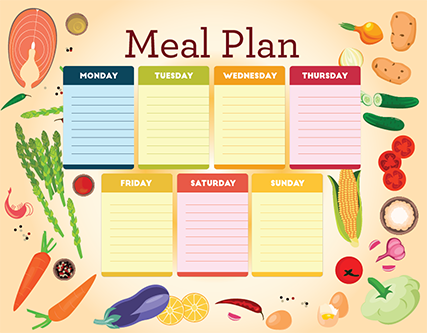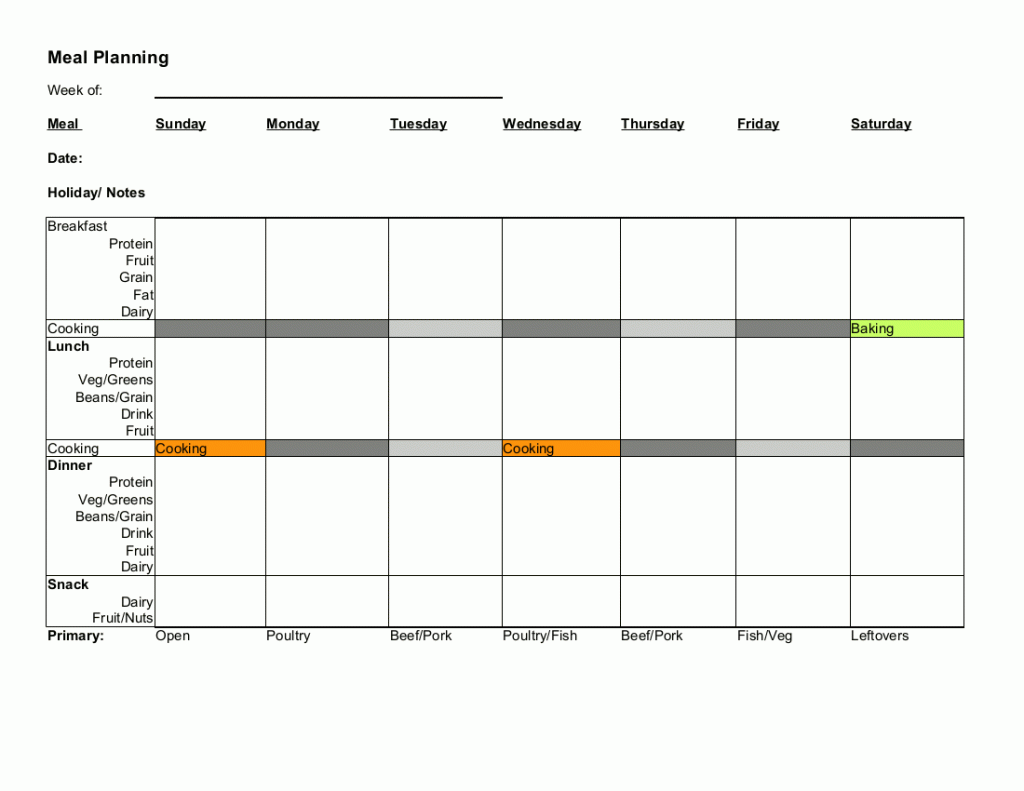Over and over again dietitians, nutritionists and diet gurus all say planning your meals ahead f time will make following your eating plan so much easier. You might note that I use the term eating plan instead of diet. While diet is the correct technical term, it has become associated with depriving yourself of some food you love for a period of time, usually with the goal of losing weight. That kind of dieting does not work. In fact, it can be more damaging to go up and down than to remain overweight. You have to find a eating plan you can live with for the rest of your life. If you get it right, you will slowly lose weight naturally and be able to keep it off.

Meal planning is a skill you might need to learn. So, how do you do it? This bit might take a few tries to get things arranged in the best way that works for you. This is not a plan that you can copy out of a book. Everyone is different, with different tastes, needs, time, and skills.
Start With A Grid
After you have been to the doctor and found out his or her advice for your particular health needs you can begin putting together your own personal eating plan. You might need a referral to a dietician or a nutritionist or a diabetes educator. They all can help you develop your eating plan.

With the paper held horizontally, or landscape, put the days of the week. Running down the left side, list your meal names. Be sure to include a space or two for snacks. If you can do this in a spreadsheet on a computer, even better. Remember, this is your generic plan without too many specifics.
Plan When To Cook
This is a vital part of meal planning. After all, it doesn’t do any good to plan your meals if you don’t make them. But you have to decide when it’s a good time for you to prepare and cook your food. Many people find Sunday afternoon and evening is a good time to prepare meals for the week. They do their shopping on Saturday and might spend another day looking through the store ads and your recipes. At least one evening a week needs to be devoted to cooking. I usually cook at least two evenings a week. When I cook, I make enough to have leftovers for a few meals.
For me, the local grocery store ad and sales begin on Wednesday, so I usually do my shopping on Thursday and I cook on Saturday and Sunday. Saturday I reserve for baking. Sundays I make one good meal with plenty of leftover servings to eat later in the week.
What To Include
I like to set aside various meals to include making and eating healthy. You can set this as hard and fast or flexible as you need. For example, I think at least three meals a week should be vegetarian, with no animal protein. That’s because we Americans eat too much meat and need to consume more vegetable protein.
Some other goals I have for preparing for the week ahead are:
- At least once a month, I bake bread. That’s usually good for two weeks if I freeze one of the two loaves I make.
- I make a pot of rice every month. Half will get put into containers and stashed in the freezer for later. The rest will go with meals during the week. Rice will last a couple of days in the refrigerator, but not much more. If it starts to smell sour, pitch it.
- Twice a month I try to make soup. Soup is very good food for all of us. You can load it with vegetables, use up leftovers, or have it with many meals. Again, extra can be frozen.
- Another monthly pot is beans. These are very easy to cook and can be used with all meals. They can be eaten hot or cold, with or without sauce, on top of salads, with your eggs and bacon, or accompanying a sandwich. Beans are full of valuable nutrition, including providing you with plant protein.
- I make my own granola. We have a [recipe here]. That means I control the amount of sugar, and I use a lot of sweetener.
Another factor you might want to consider is things like fish on Fridays, or regular events that will affect your planning.
What’s On Sale This Week?
The next step is to see what’s on sale at the grocery store. You don’t really have to do this step, but it will save you money. Look for sales on any items you use regularly, plus a principal protein around which you can plan your meals.
If it looks like you’ll have extra produce or other ingredients, look for recipes that will let you use them up.
Look for recipes that will not exceed the amount of time you have to devote to planning and cooking. The idea is to make it easier for you to stick to your eating plan.
Consider the number of servings you will be making. If you’re a bachelor on your own, you should always get at least two meals out of everything you cook. Put leftover meals into your plan.
You Must Have A List
I don’t care how good your memory is, there’s something about writing things down that makes them more real and more likely to be followed. Once you have your recipes, make your grocery list. I like to keep a running list I can add two as I run out of things or some staple gets low. Having a list makes it less likely you will forget something. It also means fewer impulse purchases. If you use a grocery delivery service, you won’t be tempted by flashy displays. Try to stick to your list as much as you can.
Preparation And Cooking
Depending on your schedule, you might have to split your preparation time from your cooking time. Try to do things in batches. I usually allow for twice as much time for prepping my meals than what the recipe calls for. Then I try to prep for more than one dish to save time later. Investing in food containers in a variety of sizes, with lids, is a very good idea.
Try grouping tasks together, such as doing all your chopping at one time. Measure out spices while you have them out for some of your upcoming recipes. Making big pots of rice, beans, soup, chili, and vegetables that you can store for later use saves a lot of time and effort.
Use A Pencil, Not A Chisel
Flexibility and variety are what make any eating plan more interesting and more successful. Nothing is written in stone. Don’t feel like you can’t be spontaneous. That’s why pencils have erasures.
Meal planning sounds like a lot of work at first. But once you get it going, it gets much easier and results in less food waste.


